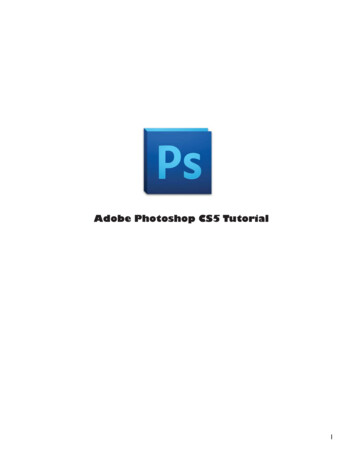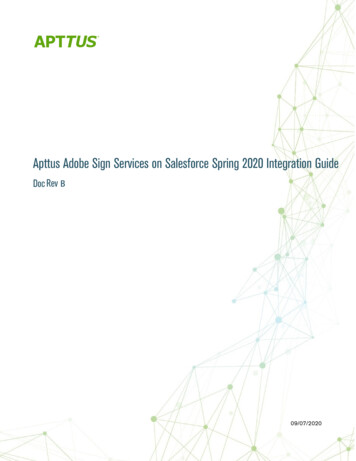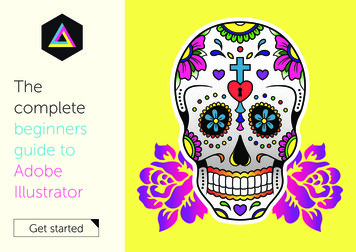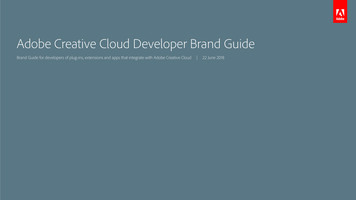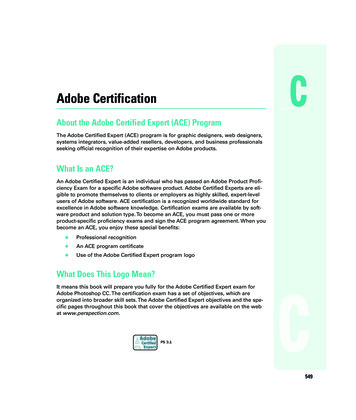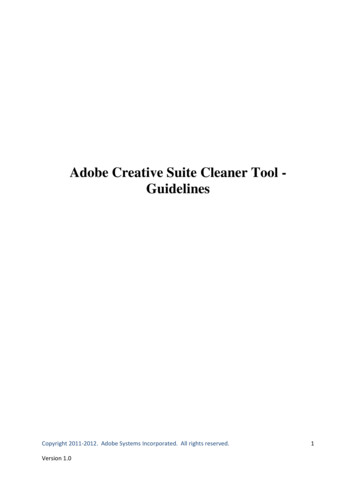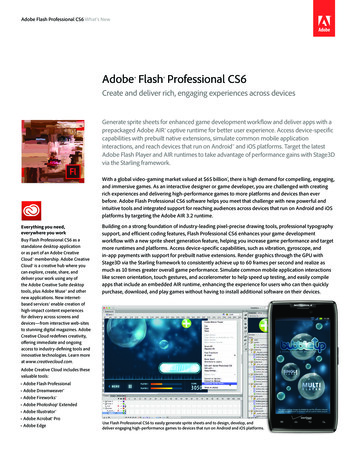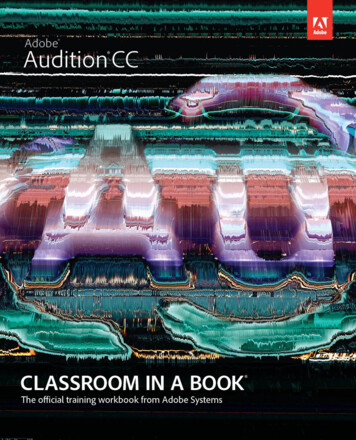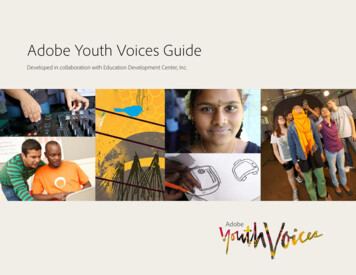
Transcription
Adobe Youth Voices GuideDeveloped in collaboration with Education Development Center, Inc.
AcknowlegementsAcknowledgementsABOUT THE ADOBE FOUNDATIONAdobe believes in the power of creativity to inspirepositive change. By harnessing the potential of itstechnology, its workforce, and its relationships withlike-minded individuals and organizations, Adobestrengthens local communities and supports a moresustainable future. Adobe focuses its efforts on four keyareas where it believes it can have the greatest impact:Innovation, Creativity, Sustainability, and Community.Adobe Youth Voices (AYV) played a central role inAdobe’s efforts to catalyze a conversation around creativity in the broader education field by illustrating thecritical need for Creative Confidence and sharing thesuccess of participating students and educators. And,by empowering youth and involving employees, AYVwas also a critical driver of Adobe’s overall commitments to corporate social responsibility.ADOBE FOUNDATION TEAMMichelle Yates, Director of Corporate SocialResponsibility and Executive Director ofthe Adobe FoundationPatricia Cogley, Senior Program Manager forAdobe Youth VoicesABOUT THE ADOBE YOUTH VOICESGUIDE CREATORSAdobe Youth Voices, including the materials andtraining strategy shared in this Guide, was developedin partnership with Education Development Center,Inc. (EDC). EDC is a global nonprofit organization thatdevelops, delivers, and evaluates innovative programsto address some of the world’s most urgent challenges in education, health, and economic development.EDC’s approach to professional development is rootedin years of collaborative work with schools, communityorganizations, and educators designing, implementing, and evaluating ways to use new technologies toenhance learning. EDC assisted the Adobe Foundationin all aspects of Adobe Youth Voices, including partnermanagement, training design, and curriculum development. The materials in this Guide draw on numeroussources, including existing Adobe and EDC publicationsas well as the work of partners and other leaders in thefields of youth media and education.EDC DEVELOPMENT TEAMTony StreitDeidre SearcyWendy RivenburghKate GoddardEDC GRAPHIC DESIGN TEAMGabby SilvaDaryl BergmanDigital Design2Adobe Youth Voices GuideFor questions about the Adobe Youth VoicesGuide, e-mail us at ayv@edc.org.Education Development Center, Inc.770 North Halsted Street, Suite 205Chicago, IL 60642http://www.edc.org800.449.5525Images in the Program Guide are culled from the program andinclude actual youth photos and video stills as well as behindthe scenes images. All belong to the artists and are licensed toAdobe Foundation.This work is licensed under the Creative Commons Attribution-NonCommercial-ShareAlike 4.0 International License. Toview a copy of this license, visit http://creativecommons.org/licenses/by-nc-sa/4.0/.
Table of contentsCHAPTER 1: Adobe Youth Voices overview»» The Adobe Youth Voices philosophy»» Creativity matters now more than ever»» Creative Confidence opens doors88911CHAPTER 2: Media making with youth»» What is youth media—a process or a product?»» Media Literacy»» Create with purpose19192022CHAPTER 3: Facilitating the creative process»» Managing the Steps of the Creative Process»» Steps in facilitating the creative process»» Using inquiry to drive the process story»» Take inspiration from the world around you»» Facilitating idea development and brainstorming»» Photography»» Video»» Graphic design»» Animation»» Audio26262727283Adobe Youth Voices Guide343637414343»» Pre-production»» Production»» Post-production»» Critique and revision»» Facilitating critical response»» Process steps45464952535555CHAPTER 6: Exhibition and Outreach24CHAPTER 4: Formats and stylesCHAPTER 5: Supporting the production process»» Getting youth voices heard»» Mapping your community»» Creating a plan»» Social media outreach»» Additional ways to reach audiences»» Artist Statement»» Understanding copyright and release forms6161636365666868CHAPTER 7: Creative Confidence in action»» Observing Creative Confidence»» Youth reflection»» Pathways to apply Creative Confidence72727577CHAPTER 8: Planning your program»» Developing your talents as a creative educator»» Making it work in your setting»» Integrating Youth Media into your classroom»» Launching an afterschool youth media program»» Creating a program plan818181838485
4Adobe Youth Voices Program Guide
IntroductionIntroduction“The experiences young people have with youth media inspire creativity and apassion to share their perspective with the world, a special combination that buildscreative confidence in youth. The thousands of media works created to date are atestament to the power of youth to think creatively about how to respond to thechallenges and opportunities they face.”Michelle Yates, Adobe FoundationThe vision of Adobe Youth Voices (AYV) was toempower young people to harness creativityand digital skills to drive change in their communities. Beginning in 2006, the Adobe Foundationmade a significant investment in young people’screativity through a network of organizations,educators, and young people. In all, 250,000youth and 5,000 educators from 60 countriesaround the world have participated in AdobeYouth Voices.At the heart of AYV is an educational methodology that provides youth with the inspiration,training, and technology to create original mediaworks on issues they care about. Through theseexperiences, youth participants hone skills ofself-expression, ideation, collaboration, flexibility,and persistence—the skills we regard as centralto Creative Confidence.5Adobe Youth Voices GuideThis Adobe Youth Voices Guide is intended toboth orient and support educators in creating,planning, and implementing innovative mediaprojects with young people. The Guide offersa road map for these learning experiences andprovides educators with planning tools, examples, and tips that will help launch and sustaineffective youth media programs. While it challenges users to develop their own approach,the Guide is also meant to inspire readers withexamples of successful projects from around theglobe. We believe the practical ideas shared inthis Guide, together with the teaching and learning resources from some of the best thinkers andartists in the field, will prove to be an invaluableresource to educators working with young media artists.In addition to the Guide, educators can freely access the entire collection curriculum andresources developed through AYV on the AdobeEducation Community. Curricula, in a variety ofmedia formats, provide educators with the activity steps and handouts for leading a youth mediaexperience. Toolkits exploring specific topicssuch as Collaboration, Exhibition, and Careers,provide additional resources and activity ideasfor going further with your youth media p rogram.An Adobe Youth Voices app that showcases educator and youth stories from around the worldis also available for download at iTunes.
How to use this guideHow to use this guideThis Guide is organized into eight chapters,beginning with an overview of Adobe YouthVoices and concluding with tools and materialsdesigned to help you launch your youth mediaprogram. We provide planning tools on an arrayof important aspects of facilitating youth media,which you can fill out online or print. These arelisted below. For convenience, we have also embedded sample youth media works and videotutorials to guide you in different stages of themedia making process.The AYV Guide is both a training manual and areference book. We anticipate educators mayread through some or all of the chapters insequence and also return to favorite sectionsfor reference as needed. A summary of the keypoints in each chapter follows.1 Adobe youth voices overview4 Formats and styles»» Understand the basic elements of AYV»» Analyze various media forms and formats interms of options, advantages, and limitations»» Learn about cultivating and applying CreativeConfidence»» Assess your capacity to deliver a completeand effective project2 Media making with youth»» Reflect on the practice of youth media andthe importance of building creative skills»» Understand AYV’s “Create with Purpose”approach and its link to Creative Confidenceoutcomes»» Connect youth media making and medialiteracyAdobe Youth Voices Guide5 Supporting the production process»» Understand the essential steps in themedia-making process»» Consider ways to facilitate reflection andrevision throughout»» Explore tools for supporting media critiqueand assessment6 Exhibition and outreach3 Facilitating the creative process»» Understand the importance of making mediaworks with a specific audience in mind»» Understand the steps in the creative processand how they are best facilitated»» Create a plan to show the work and share viasocial media and other venues»» Explore approaches to facilitating inquirybased learning that foster problem-solvingand creativity»» Consider issues related to ownership andcopyright»» Discover idea development and brainstormingtechniques to help young people formulateproject ideas6»» Think about which approaches will work bestfor your site and your young artists
How to use this guide7 Creative Confidence in actionList of Planning Tools»» Build awareness of when and how youthdemonstrate Creative Confidence in their work»» 1.1: Setting your goals»» Support and promote youth reflection throughindividual and collaborative activities»» 3.1: Developing your technique»» Encourage young people to consider theways that creative skills will support them inlife, school, and careers8 Planning your program»» Set your own professional developmentgoals»» Consider the specific needs of yourparticular setting»» Create a concise, reflective program plan7Adobe Youth Voices Guide»» 1.2: Assessing your readiness»» 5.1: Planning project stages»» 5.2: Lesson plan»» 6.1: Targeting your audiences»» 8.1: Program plan»» 8.2: Building your skills»» 8.3: Collaborating with others»» 8.4: Project supplies, materials& other resources
CHAPTER 1Adobe Youth Voices overviewAdobe Youth Voices overview» Understand the basic elements of AYV» Learn about cultivating and applying Creative Confidence» Assess your capacity to deliver a complete and effective youth media projectAdam Kennedy,Youth media maker“Adobe Youth Voices provides the community, the tools,and a global audience for young artists to begin theirjourneys as media makers. It does more than justprovide the technical knowledge to perform differenttasks. It helps to create an infrastructure for how tothink critically as a storyteller and as a listener.”8Adobe Youth Voices GuideTHE ADOBE YOUTH VOICES PHILOSOPHYYoung people the world over care deeply aboutthe issues facing their families and communities.They have unique insights into problems andbring their imaginations to bear on creative solutions. However, for youth, as for anyone, it takesconfidence to find and share one’s voice.Like any skill or talent—from artistic performance to sports to business acumen—creativeskills are honed over time. Creating digitalcontent often comes easily to youth, who areimmersed in technology in their everyday lives.While a young person can practice a skill suchas media making on his or her own, an effectivemedia educator functions as a coach to reinforcegood form, recommend ways to improve, andprovide continual moral support. Your challengeas an educator is to provide the guidance andspace for young people to create media withoriginality, vision, and purpose.While participating in a media project, youthwork both individually and in groups to develop an idea, “pitch” the idea to their peers, andrefine it to best articulate their creative vision.They then learn the technology skills that enablethem to express their concept in an innovativeand creative way. In this process, they engagewith an idea and concept that has inherentmeaning to them—building their own resiliencyand voice.Young media makers take risks with their projects, one way in which they’re demonstratingCreative Confidence. Many works in the AYVcollection exhibit great courage on the part ofyoung people as they seek to address real problems in their lives. It is a hallmark of youth mediamaking that educators urge youth to investigateand pose solutions to problems of equity, justice,and the rights for all. We know from experiencethat asking young people to address real world
CHAPTER 1Adobe Youth Voices overviewissues has power and resonates with their desireto make the world a better place.Oredola Kayode,Youth media maker“AYV has given me a sense of purpose. When Icreate a video or a photo collage, it feels likeI am a voice for my community, and I feel I owethis to my community.”There is a long tradition of integrating youthmedia making into learning and youth development, encouraging young people to reflecton the role of media in our lives and to makeoriginal works that speak to the needs andissues of all youth. This tradition inspired Adobe’s challenge to youth to be purposeful in theirmedia making, that is, to Create with Purpose.This challenge reflects a strategy and instructional technique meant to foster a highly intentionalapproach to media making—one that is designed to have impact and effect change.When educators guide young people toCreate with Purpose, youth produce mediathat is:»» Relevant (to the media makers and the audience)»» Intentional (designed to have a clear impacton an intended audience)»» Personal (expressing a clear point of view orspecific perspective)»» Collaborative (youth and educators workingside by side)»» Original (evident in style and content)9Adobe Youth Voices Guide»» Inquiry based (derived and led by youthquestions)»» High quality (illustrating the effective use oftools and techniques)Techniques for fostering these attributes will bereinforced throughout this Guide and will helpyou as an educator better facilitate media creation and learning along the way.CREATIVITY MATTERS NOW MORETHAN EVERTrue learning is creative in nature—it involvesquestioning, seeking answers, and addressingproblems by applying novel ideas. Increasingly,jobs require creative skills. Global issues requirecreative, original thinkers to craft solutions.Creative people are better able to navigate life’schallenges and imagine pathways to a betterworld.»» Creativity is essential for problem solving andinnovation, today and for our future:»» Creativity was cited as the top leadership competency for the future (IBM CEO Survey).»» Creative countries are more economicallyresilient (United Nations Creative EconomyReport of 2010).
CHAPTER 1Adobe Youth Voices overview“We all create our own livesthrough this restless processof imagining alternativesand possibilities. One of theroles of education is toawaken and develop thesepowers of creativity.”Sir Ken Robinson,Creativity ExpertMobile Devices:Link to video Cambio JovenesYouth possess the power to change the worldthey live in. They merely have to desire it.Cambio Jovenes is an upbeat look at how we canshape the globe around us. Utilizing stop motion,this fun film inspires the imagination.10Adobe Youth Voices Program Guide
CHAPTER 1Adobe Youth Voices overviewNevertheless, creativity is undervalued, particularly in education where it should be cultivatedand thriving.»» The United States is in a creativity crisis due tooutmoded education systems (Newsweek),and globally, students aren’t being equippedwith necessary creative skills (Time).»» “The biggest challenge facing our children istheir inability to think realistically, creatively and optimistically about the future.” –TheFuturist»» Adobe’s research shows the majority of people worldwide feel education systems stifle creativity.We believe that by supporting and expandingcreativity in education, we will better prepareyoung people to be the problem solvers, criticalthinkers, and leaders in an increasingly complex,interconnected society. Adobe Youth Voices isabout helping youth realize their creative potential—and transform the world.CREATIVE CONFIDENCE OPENS DOORSAdobe Youth Voices has always had creativity atits core, inspiring youth to grow and demonstratetheir creativity through the media-making process. More than just developing technical skills,young people are challenged to find their voiceand make it heard on the issues that are centralto their lives. Consequently, by participating inAYV, young people build what we call “CreativeConfidence”—the ability to harness creativeskills to solve problems. Through media making,young people develop important life skills thatreveal their emerging Creative Confidence:»» Self-expression—the ability to express apoint of view»» Ideation—the ability to come up with originalideas and innovate»» Collaboration—the ability to engage andwork cooperatively with others»EDUCATOR SPOTLIGHTThomas JosephChristel House, Bangalore, India“Children enjoy listeningto music and they enjoysinging. I want to keep thisalive in them and help itgrow. The AYV projectsgave them an opportunityto work as a team. The children were ableto draw inspiration from nature and soundsin nature—bird calls, rain and thunder,rustling of leaves, and so on. We replicatedthese sounds in our music videos. Thisgave an occasion to teach them how vitalit is to take care of our environment.»» Flexibility—the ability to adapt»» Persistence—the ability to stick with a challenge through to completion“While we’ve strived to provide youth and educators a roadmap for creating innovative youth media,the success of AYV Curriculum is due to the extraordinary creativity and enthusiasm of participantsall over the world. It is really remarkable for us to witness the way that these strategies have beenembraced in so many different settings, perhaps demonstrating the profound need to approacheducation in a new light and to listen intently to the vision and wisdom of our young people.”Tony Streit, Education Development Center11Adobe Youth Voices Guide
CHAPTER 1Adobe Youth Voices overviewUsing AYV strategies that prompt thoughtful,deliberative reflection, educators guide youth inidentifying the skills they acquire in the program,helping them contemplate, understand, andultimately “own” what they have learned. Youwill learn how to lead young people to reflect onthe ways that Creative Confidence can supportthem in life, education, and career paths. Withyour guidance, youth will come to value theirnew-found Creative Confidence and apply it intheir schools, homes, communities, and work—in fact, any place where they endeavor to havean impact.The AYV materials present various opportunitiesfor you to appraise your own experience withcreativity and to consider how that experiencecan influence your work with young people.As you develop your own youth media program,we want to help you plan for success. How willyou design a set of activities that engage andempower youth, aligned to the AYV approach?Use the next two planning tools to think aboutthe impact you want your program to haveand the skills and expertise you will need to besuccessful.Reflect12Adobe Youth Voices GuideCreativeConfidence inPracticeWhat might Creative Confidence look like in your program?How might educators witness young people applying theirnewfound skills?Self-expression—Young people are able to articulate a coherent and powerfulargument for something they believe in.Ideation—Youth envision a world that is different than what they know and use mediatools in ways that defy convention to show us a better world as they imagine it.Collaboration—Engaging and working together as peers, youth broaden theirperspectives, learning about and integrating multiple points of view. Collaborationenriches their project work but more importantly their relationships with one another.Flexibility—In the process of making media, youth often encounter the unexpected.Not letting uncertainty, frustration, or conflict derail their work, youth demonstrate theability to flex or bend, often coming up with inventive solutions to problems.Persistence—Creating compelling media takes time. Young people often struggle andsometimes lose interest or focus along the way. However, following through frombeginning to end is a great accomplishment and an extremely rewarding life lesson.Contemplate your experience with creativity. What role has creativityplayed in your life (as a learner, educator, artist, parent, etc.)? Howmight creativity be used to transform your instructional practice?
CHAPTER 1Adobe Youth Voices program overview1.1: Setting your goalsGood youth media practices are intentional and well-planned.This worksheet is designed to help you think carefully about the impactyou hope to have on those you serve. Take a few minutes to thinkabout your goals and what you intend to accomplish.»What are your overarching goals for incorporating youth media making into your work with youth?123»13How will you know if you are making progress toward these goals?Adobe Youth Voices Guide
CHAPTER 1Adobe Youth Voices program overview1.1: Setting your goals cont.»What unique experiences and perspectives do you bring to this work?Media making experienceExperience promoting creativity& self-expressionOther areas of expertise»Who will you need to involve in achieving your goals? What will they contribute and how will they benefit?At your school/youth centerFamilyCommunity and beyond14Adobe Youth Voices Guide
CHAPTER 1Adobe Youth Voices program overview1.2: Assessing your readinessUse this to identify the skills and strategies necessary to develop an effective youthmedia project and cultivate Creative Confidence. Check the box which most appliesto your current skill level and note where you feel improvement is needed and thekind of support you might require. Note that each section of this assessment relatesto a corresponding chapter of this Guide. Use it as a quick reference to areas youmay need to work on and investigate further.Success ort You NeedMedia making with youthFamiliarity with the practice of youth media and withmedia literacyAwareness of what your young people value and care aboutAwareness of your youth’s educational aspirationsand career interestsFamiliarity with positive youth development principles(continues on next page)15Adobe Youth Voices Guide
CHAPTER 1Adobe Youth Voices program overview1.2: Assessing your readiness cont.Success ort You NeedFacilitating the creative processAwareness of what motivates your young people to learnKnowledge of constructivism and project-based learningCapacity for fostering creativityFamiliarity with brainstorming techniques and other waysto promote idea developmentExperience leading project-based learning withyoung people»Formats and stylesUnderstanding a variety of media (print, video, graphics,animation, etc.)Familiarity with media-making hardware and softwareExperience assessing youth’s media and technical skillsCapacity to guide youth in choosing among formats andstyles for their media project(continues on next page)16Adobe Youth Voices Guide
CHAPTER 1Adobe Youth Voices program overview1.2: Assessing your readiness cont.Success ort You NeedSupporting the production processUnderstanding the steps of the media-making process fromplanning through exhibitionSelecting developmentally appropriate learning activitiesKnowledge of basic storytelling principlesFacilitating collaboration and critiqueAccess to media production tools – computers, audio recorder,video camera, still camera, etc.Engaging community members (youth, parents, creativeprofessionals, government officials, etc.) in projects»Exhibition and outreachDefining an audience and crafting a messageOpportunities/space to host events or display youth worksGuiding youth in preparing for exhibition(continues on next page)17Adobe Youth Voices Guide
CHAPTER 1Adobe Youth Voices program overview1.2: Assessing your readiness cont.Success CategoryExperience mapping resources and assets within yourcommunityFamiliarity with conducting social media outreachUnderstanding copyright issues and release forms»Creative Confidence in actionUnderstanding the skills comprised in Creative ConfidenceObserving youth’s skill development over timePromoting youth reflection during the creative processFamiliarity with opportunities for youth to apply theircreative skills beyond program»Planning your programCapacity to incorporate media making into existingprogramming or curriculumTime and resources available to practice new techniques orseek additional trainingExperience developing and implementing a program plan18Adobe Youth Voices GuideStrongGoodFairNeedsImprovementNotes/Support You Need
CHAPTER 2Media making with youthMedia making with youth»EDUCATOR SPOTLIGHTOneisha FreemanWhitefoord Computer Clubhouse,Atlanta, Georgia, United States“The work that I do withAdobe Youth Voices is anessential part of the learningexperience of the Whitefoord Clubhouse youth. Theopportunities that the youthare afforded by participating have impactedand enriched their lives in ways we could havenever imagined. Facilitating the media-making process and helping develop the mindsof young people each day is important toreaching the goals set here at Whitefoord—ensuring every child has what he or she needsto succeed in life.”19Adobe Youth Voices Guide» Reflect on the practice of youth media and the importance ofbuilding creative skills» Understand AYV’s “Create with Purpose” approach and its link to CreativeConfidence outcomes» Connect youth media making and media literacyYouth media making gives young people the opportunity to build creative skills and express theirunique perspectives of the world around them.Youth media as a practice is fundamentally project-based learning—a creative process in whichyoung people formulate media project ideas andthemes, plan their production, review their workand the works of others, and share their originalmedia products with an audience in hopes ofinforming them and having an impact. AdobeYouth Voices builds on a long tradition of civicengagement in youth media making. The goal isto bring these digital media tools and practicesto more people around the world, empoweringyouth to make positive change.YOU MIGHT ASK, WHAT IS YOUTH MEDIA—A PROCESS OR A PRODUCT?Yes, the term youth media can refer to theend product, but it is also a facilitated processthat engages young people in critical thinking,collaboration, and technical skill development.As you embark on perhaps your first effort tofacilitate youth media making, know that you area part of a larger community of artists, teachers, educators, and youth who have discoveredthe powerful ways that media making deepenslearning. For more than 40 years, youth mediahas integrated constructivist techniques that areideally suited for engaging youth in explorationsof personal and community issues while at thesame time cultivating technical and cognitiveskills. Youth media educators have been highlyeffective at supporting the creation of unique,
CHAPTER 2Media making with youthindependent media that speaks for youth interests and issues. The work is exciting and innovative, and reflects the creativity and determinationof young people who are eager to tell their ownstories and make a difference.It is our hope that by integrating these principlesinto your instructional practices, you will contribute to the continued growth of the youth mediafield while helping your youth develop theircreative skills and have an impact on our society.Media LiteracyA key part of making media with youth is teaching critical mediaanalysis or media literacy. Media literacy provides the foundationfor youth media practice.As a concept media literacy means the ability to interpret and communicate meaning in media.Media literacy turns the passive act of receiving a media message into action through thepractice of decoding, reflecting, questioning, and ultimately creating media. It encompasses theability to recognize propaganda and bias in the news, understand the impact of media ownership and sponsorship and identify stereotypes and misrepresentations of gender, race and class.Commercial and entertainment content targets young people as consumers, yet many youthfeel that mainstream media does not reflect their lives as they truly live them. Their peers andcommunities are often portrayed negatively and stereotyped, and news stories about youth arerarely more than crime reports. When youth find or fail to find themselves reflected in the media,there is an opportunity to discuss feelings of isolation and address issues of disparity, bias, class,and equity. Media-literate young people define their relationship to media content rather than letthe content dictate their place in society.Media-literate young people ask critical questions that help them better understand the intentbehind a media work. When listening or viewing media, youth may ask:Q.20Adobe Youth Voices Guide»»»»»»»Who produced this work?Where are they from?What are their attitudes and values relative to my own?What are they attempting to achieve through this work?Are they trying to change my perspective in some way?Do I agree with their point of view?How can I respond to their work?
CHAPTER 2Media making with youth“What we have is thiscreative confidence that,when given a difficultproblem, we have a methodology that enables us tocome up with a solutionthat nobody has before.”David Kelley,IDEO Founder andInnovation ExpertMobile Devices:Link to video Creativ.In our city we have many young artists. We madethis video to express our admiration for them. It isalso a tribute to all the young people in the worldwho are not afraid to follow their passions andcreativity.
CHAPTER 2Media making with youthCREATE WITH PURPOSEAdobe’s appr
empower young people to harness creativity and digital skills to drive change in their commu-nities. Beginning in 2006, the Adobe Foundation made a significant investment in young people’s creativity through a network of organizations, educators, and young people. In

